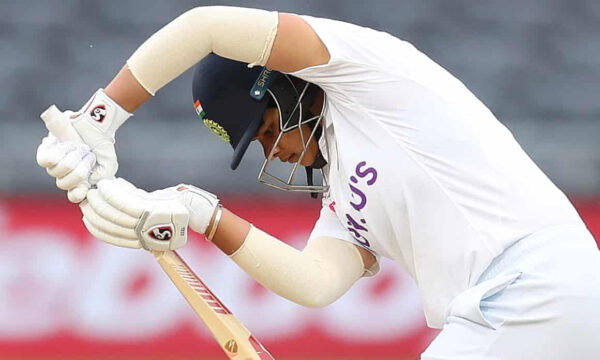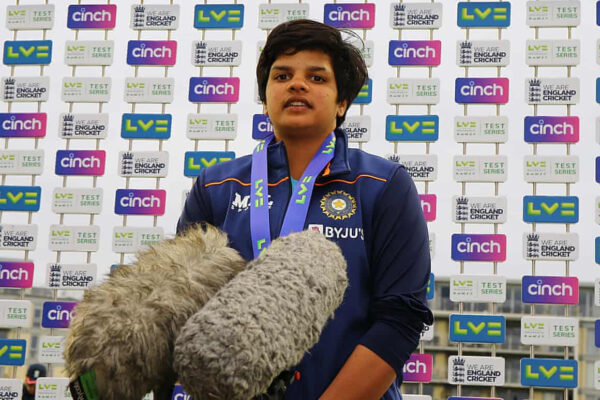Shafali Verma shows the way for future female stars of Indian cricket-by Tanya Aldred
Supremely talented 17-year-old should make the BCCI realise how big the women’s game could be

India’s Shafali Verma was player of the match against England in the Test at Bristol. Photograph: Ashley Allen/Getty Images
 Tanya Aldred
Tanya Aldred
| Just as more people saw Jim Laker whistle out 19 for 90 at Old Trafford and Ian Botham bristle 149 at Headingley than could possibly have fitted in the ground even stacked cheek to jowl and on top of each other, you suspect Bristol County Ground will have been rather fuller in retrospect than it was last week. Not because it was the first time India had played a Test for seven years or because of the cricket itself, which was excellent, but because of the Test debut of a 17-year-old superstar in the making. Shafali Verma made 96 and 63 and was named player of the match. But it wasn’t just the numbers. It was the poise, the power, the audacity. The simple dismissal of the bad ball. The delicacy of the glide down to third man. The big, booming straight drives. The steady forward defensive with the high, high elbow. The teenage impetuosity of going for the big shot when on 96 and the sighing disappointment of the spectators, whose instinct for the home side was temporarily beaten by their empathy. Verma’s story is not one of a golden girl destined for glory. She comes from Haryana, a socially conservative state in northern India with a traditional view of the role of women and a disapproving gaze on girls playing sport outside. In the 2011 census, Haryana’s sex ratio at birth (SRB) was 834 (834 girls born for every 1,000 boys) – the lowest in the country. By March 2018, through a campaign of celebrating female achievement and closing down illegal sex-determination ultrasound clinics, the SRB had improved to 928 – but there is still a long way to go. |
Sneh Rana’s superb rearguard effort denies England as India dig in for draw
|
| But Verma didn’t care so much for what others thought of her. She cut her hair short, cycled 15 miles to school and played cricket with her brothers under the watchful eye of her father, Sanjeev, a jeweller. When her older brother Sahil fell ill and couldn’t compete in an under-12 tournament, 10-year-old Shafali convinced her father that with her shorn hair she could slip under the radar and play instead. She did and won the man of the match award. “I was lucky to have an upbringing that’s so different from most girls of my age. Many scoffed at the idea of a girl playing an outdoor sport with boys, but dad was adamant,” Verma has said. “Despite the discouragement, dad gave me everything that he would give to my elder brother.” Sanjeev carried on with the vigorous training of his children. There was a police training ground near to the family house where Shafali and Sahil would compete to flip over monstrous tractor tyres, while earning five rupees from their father’s pocket for every six they could hit. Shafali started playing for the state side and in 2019, at the age of 15, was called up for the Women’s T20 challenge, organised by the BCCI and held in Jaipur. Verma played for IPL Velocity, captained by the India Test captain, Mithali Raj, and alongside England’s Danni Wyatt, who came home saying she had played with a future superstar. |
 |
| Shafali Verma speaks to the media after the Test draw. Photograph: Ashley Allen/Getty Images |
| The baton was passed when Raj retired from T20 internationals and Verma was called up for the T20 squad against South Africa. She hiccuped, making nought in her first match, but a month and a bit later stroked a couple of fifties in successive games against West Indies, breaking her hero Sachin Tendulkar’s record as the youngest Indian to make an international half-century. Since then: boom, boom. She has hit more sixes in international T20s since her debut than anyone else and is the top-ranked women’s T20 cricketer. In the Women’s T20 World Cup in Australia last year, she sparkled, scoring 163 runs at a cool strike rate of 158.2, even if she flopped in the final as Australia, roared on by a record crowd, were triumphant at the MCG. She has signed T20 deals with the Sydney Sixers and Birmingham Phoenix. |
How to support our sports coverage (without asking a billionaire) | Jonathan Liew
|
Despite all this, despite her knock-‘em-dead sensationalness and potential, Verma probably isn’t a one-off in a country with a population of 1.36 billion. England and Australia have been used to dominating women’s cricket for years, but you sense that crown will slip very soon. Ever since Harmanpreet Kaur scored a knockabout 171 in the 2017 World Cup semi-final to knock out Australia, ever since India made it to the final at a full Lord’s and Mithali Raj read a book while waiting to bat, the Indian women’s cricket revolution has been ready to roar. The women’s side’s recent treatment by the BCCI makes you wonder if the authorities realise quite what a golden egg they are sitting on. The fact India’s women didn’t play a match for nearly a year after the T20 World Cup final while the men played eight Tests and six white-ball matches, the fact they weren’t paid the prize money owed to them for getting to the final for more than 14 months, the fact the men played a full IPL while the women got a four-match mini-tournament. But this will change. It has to. Player power will soon come to mean something, just as it does in the men’s game. And Verma will be leading the way. Catch her while you can – India and England play three more ODIs and T20s on this tour, before she joins Birmingham Phoenix in the Hundred. |
Quote of the week“I am so happy to have contributed with both bat and ball in a hard-fought game. And at last, this is for my angel, my father. I am sure he is somewhere up there, watching me and blessing me every step of the way. Papa, I hope I make you proud, always” – Sneh Rana after her Test debut where she scored 80 not out to ensure India finished with a draw. Warning from the CaribbeanThe Hit for Six report, measuring the effect of the climate crisis on cricket, was published in September 2019. More striking than almost anything in its hard-hitting pages was the foreword, written by Kevin Mitchell, the prime minister of Grenada. “Climate change is real,” he wrote. “It’s as simple as that. Every ball bowled at us is currently a bouncer. We’re ducking so much we’re struggling to build an innings that will ensure a safe, secure and sustainable future for our people.” Twenty-one months later and Grenada, savaged by Hurricane Ivan in 2004, continues to suffer along with other Caribbean islands. As the number and intensity of hurricanes and tropical storms hitting the Caribbean increases, the islands are also very vulnerable to rising sea levels and at risk of salt water intruding into freshwater sources. Mitchell, who is in his second spell as prime minister and was a keen cricketer, captaining Grenada in 1973, is not about to let anything rest. On Monday, he will deliver the 21st Frank Worrell Memorial lecture on “Sport and Climate Change.” It will be live streamed on www.uwitv.org (at an antisocial 1.30am BST). Previous speakers at the lecture series have included Prof Sir Hilary Beckles; John Major; Wes Hall and Michael Holding. The inaugural lecture took place in 1994, in memory of Worrell who joined the University of West Indies after retirement as the Warden of the Irvine Hall of the Mona Campus. He went on to become the UWI director of sports before developing leukaemia and dying at 42. Still want more?The cricket authorities have failed the black community for years, says former Surrey player Lonsdale Skinner. Gary Naylor finds the T20 Blast is hitting the heights, especially in the north. And Ali Martin hears that Jos Buttler is troubled by England’s rotation policy and busy 2021 schedule. |








